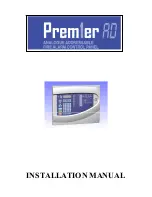
Installation and
Operating Instructions
Product features
• Battery-operated smoke detector with photoelectric scattered-light
principle
• Automatic self-test of the smoke development
• Up to 10 smoke detectors can be interconnected
• Loud pulsing alarm sound approx. 85 dB(A)
• Battery replacement display
• Soiling/Fault display
• Integrated test button for function test
• Battery compartment check: If no battery is inserted in the battery
compartment, it cannot be latched into the base
• 1 slot for holding an optional module while simultaneously using the
interconnect terminal
• Polarity reversal protection: Device destruction through incorrect
battery connection impossible
• VdS approval: certified and approved by the German "Verband der
Sachversicherer (VdS)"
Safety instructions
• Do not paint over the smoke detector.
• Smoke detectors only recognise the smoke of a fire, not the flame it-
self.
• Smoke detectors do not extinguish a fire. In case of an alarm search
for the source of the fire and, if necessary call the fire brigade (also
refer to "Correct behaviour in case of fire".
• Do not use rechargeable batteries (accumulators) or power supply
units as the voltage supply source. They can cause malfunctions or a
premature failure of the device.
• The smoke detector generates a very loud and shrill sound which can
damage your hearing. Therefore stay at least 50 cm away from it dur-
ing an function test.
• The smoke detector only monitors a defined area around the mounting
site. Install a sufficient number of detectors to cover the entire living
area and to provide optimal protection.
• Persons under the influence of alcohol or drugs might not be woken
up by the signal sound.
Correct behaviour in case of fire
Giving an alarm
Notify the fire brigade immediately. Remain calm and answer the ques-
tions you are asked clearly: Where is it burning? What is burning?
How many persons are injured? Who is calling?
Be ready to respond to any further questions of the fire brigade.
Rescuing
Rescue yourself and endangered persons from the danger area.
In case of strong smoke formation keep close to the floor and press a
moist cloth against your mouth and nose.
Do not use any lifts.
Close the doors and windows of burning rooms in order to prevent the
fire and smoke from spreading.
If it is not possible to flee out of the building, find a safe room, close the
door and draw attention to yourself at a window. Seal any gaps at the
door with wet sheets or towels in order to prevent the smoke from enter-
ing the room
Extinguishing
Try to extinguish an emerging fire with an available extinguisher. Small
fires can often be suffocated with a blanket. Never extinguish a fat fryer
with water. Cover the fire with a lid.
If your attempts at extinguishing are not immediately successful,
leave the burning room.
Mounting site
Example of a home
:
Minimum protection,
one smoke detector in
the corridor or stair-
well of each floor
:
Optimum protection,
one smoke detector in
each bed- and living
room
Preferably install the smoke detectors before or in the bedrooms so that
the occupants are woken by the smoke alarm during the night.
Mount the smoke detector in the middle of the room under the ceiling
to achieve optimum detection characteristics. If this is not possible,
observe a minimum distance of 50 cm to the wall.
A smoke detector can monitor a room with a maximum of 60 m² area
and up to a maximum room height of 6 m.
Install the smoke detector in the kitchen as far away as possible from the
cooking zone in order to avoid false alarms through water vapour.
Example of a residential building
:
Minimum protection,
one smoke detector in
the corridor or stair-
well of each floor
:
Optimum protection,
one smoke detector in
each bed- and living
room or cellar room
In buildings with several storeys mount at least one smoke detector in
each storey corridor.
Use several interconnected smoke detectors in larger houses in order to
cover the entire living area. If smoke is detected by a smoke detector, it
triggers an alarm and activates all the connected smoke detectors which
then also issue an alarm. This ensures, for example, that you are woken
during the night in your bedroom by your interconnected smoke detec-
tor when the smoke detector in the cellar detects smoke.
Example for particular room geometries
In L-shaped rooms or
corridors the smoke
detectors should be
installed on the centred
intersections of the
two sections.
In the case of large
L-shaped rooms, each
section is regarded as a
separate room.
Unsuitable mounting sites
In order to avoid false alarms, do not mount the smoke detector:
• In rooms in which strong water vapour, dust or smoke arise under nor-
mal conditions.
• Near fireplaces and open fires.
• Near ventilation shafts because the air stream may prevent the smoke
from approaching the detector.
• Near fluorescent and energy-saving lamps, because the starter switch
may trigger false alarms through the electrical fields arising when the
lamp is switched on (minimum distance: 50 cm).
• In rooms which are higher than 6 m.
• Directly in the roof apex. Observe a minimum distance of 30 cm to the
roof apex.
• In rooms with temperatures under +5 °C or above +45 °C.
Installation and commissioning
1. Mount the base with the enclosed mounting material.
2. Use the spacers if the cable for interconnecting several smoke detec-
tors has to be laid on the surface.
3. If necessary, carry out the corresponding steps for interconnecting
several smoke detectors. For further information please refer to
"Interconnecting smoke detectors".
4. If appropriate, insert a module.
5. Connect the 9 V monobloc battery to the battery connection and
insert the battery into the battery compartment.
6. Insert the smoke detector into the base and latch it in by turning it
slightly clockwise.
7. Carry out a function test.
Legend
1 Smoke detector
2 Module interface
3 Terminal block
4 Base
5 Spacers
6 Dowel
7 Screws
8 Monobloc battery (9 V)
9 Test button
Avoid vertical mounting of the smoke detector
The smoke detector should be mounted horizontally as far as possible
in order to ensure fault-free functioning. Vertical mounting (for example
on the wall) can cause malfunctions.
i
Insert battery
The smoke detector cannot be latched into the base without a battery.
i
Caution!
The operation of the smoke alarm may be
affected by air currents. When mounting the
smoke alarm on cavity structures, use the
seal!
6
5
4
3
2
1
7
8
9
Smoke detector modular/VdS
1141 ..
Gira
Giersiepen GmbH & Co. KG
Electrical installation
systems
P.O. Box 1220
42477 Radevormwald
Germany
Tel + 49 21 95 / 602 - 0
Fax + 49 21 95 / 602 - 119
www.gira.com
info@gira.com
41 0
5
49
45/08








